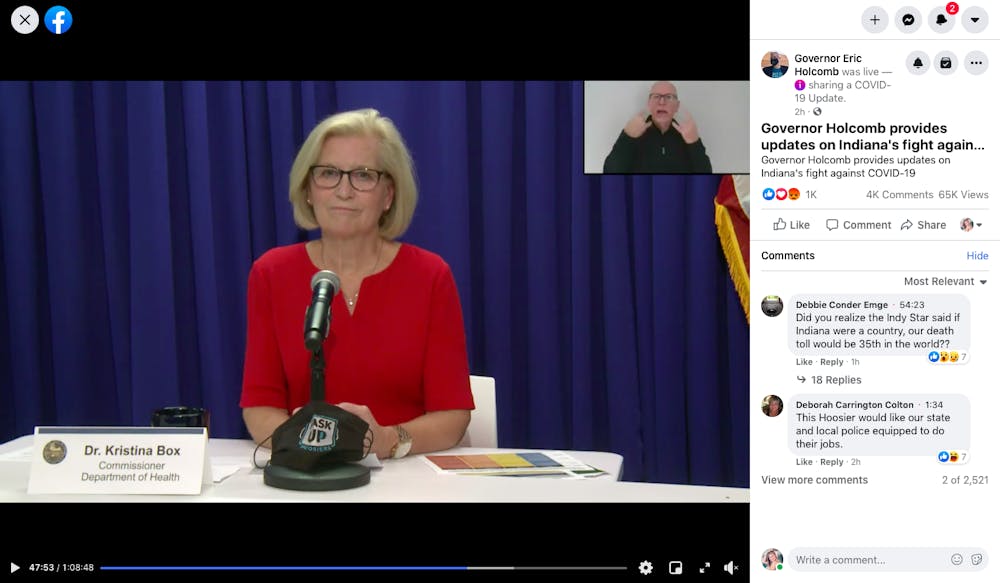Three medical professionals from IU Health Methodist Hospital, Beacon Health System and Schneck Medical Center spoke at Gov. Eric Holcomb’s COVID-19 press conference Wednesday about the effect of the surge of COVID-19 hospitalizations in Indiana.
All of them expressed the toll these numbers have had on staffing levels, staff mentality and exhaustion and their facilities' ability to help non-COVID-19 patients.
Dr. Kristina Box, Indiana State Department of Health commissioner, said 2,951 Hoosiers were hospitalized as of Monday and about 300 Indiana residents are being hospitalized for COVID-19 every day. Also, as of Nov. 10, the seven-day positivity rate was 12%.
Dr. Mark Luetkemeyer, chief medical officer for IU Health Methodist Hospital, said 80 COVID-19 patients are at the hospital today and 30 of them are critically ill in the intensive care unit. The hospital has more than doubled its COVID-19 hospitalizations since the beginning of November, he said.
“We expect these numbers to continue to increase as you look at that trend on the community spread,” Luetkemeyer said. “That has us really nervous.”
Luetkemeyer said he is most worried about the health of hospital staff and health care workers. Out of about 34,000 IU Health employees, 686 of them are quarantined. While that may not seem like a high percentage, every employee in quarantine means possibly one less person they are able to take care of, he said.
“A bed is just a bed,” he said. “A room is just a room. But if you put that with highly skilled professionals, that becomes a hospital.”
Sarah Paturalski, vice president of nursing and clinical services at Beacon Health System, said she has seen the high death rate of COVID-19 patients affect morale of frontline workers. She said the hospital is averaging at least one death per day from COVID-19.
“Death in the numbers we’re seeing with COVID is not what we’re used to,” Paturalski said. “We’re seeing death at a much higher rate than we’ve ever experienced before and it is affecting every single layer of our organization.”
Paturalski said because the COVID-19 patients are not allowed to have visitors often, the workers have had to serve several roles for them in addition to caregiver, including friend and family member. Many workers have sat at patients’ bedsides as they die because of the hospital’s vow to never let anyone die alone, she said.
“It is very, very emotionally tough for them to be absolutely everything for absolutely everybody,” Paturalski said. “We are holding their hands as they pass, when just moments before we tried to save them.”
Dr. Eric Fish, CEO of Schneck Medical Center, said now the demand for patient care exceeds the amount of staff they have. In order to address this, some health care staff has been redeployed to inpatient and critical care units. This means other areas such as surgery have had to delay patient care, Fish said.
“Just imagine if your loved one had a preventative screening colonoscopy scheduled and that screening was postponed?” he said. “What if your loved one had a growing tumor that could not be discovered for two to three months?”
This week on Indiana’s color-coded COVID-19 map, there is one yellow county, 72 orange counties and 21 red counties. Monroe County, which was yellow last week, is now orange.
Box said many of the new cases are trending back to the 18 to 30-year-old group, which is concerning because many Indiana college students are returning home this week.
“My guidance to every student coming home is this: behave as if you have COVID or have been exposed,” Box said.
Box said these students should quarantine 14 days at home after they arrive and wear a mask at home around family members during that time. She also said they should avoid seeing their older relatives, hometown friends or going out to bars.
Box said Hoosiers should try to have smaller holiday gatherings this year in an effort to stop the spread of COVID-19. Some low-risk holiday activities she suggested are having a virtual dinner with family, shopping online rather than in person and watching sports or parade activities at home.
Box said she will not be seeing her brother or sister-in-law during the holidays because they are high risk. She said she was willing to sacrifice this year of celebrating in order to ensure they will be around for more holidays and birthdays in the future.
“There will be more than 5,000 empty seats at Indiana Thanksgiving tables this year because of COVID-19,” Box said. “Let’s all make those hard choices to prevent that number from growing so that Hoosier families are able to celebrate for years to come.”




